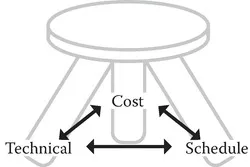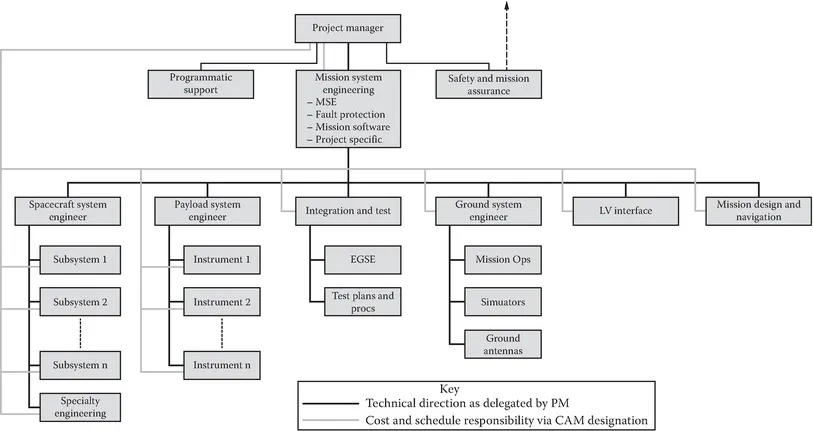
This is a test
- 423 pages
- English
- ePUB (mobile friendly)
- Available on iOS & Android
eBook - ePub
Aerospace Project Management Handbook
Book details
Book preview
Table of contents
Citations
About This Book
The Aerospace Project Management Handbook focuses on space systems, exploring intricacies rarely seen in land-based projects. These range from additional compliance requirements from Earned Value Management requirements and regulations (ESA, NASA, FAA), to criticality and risk factors for systems where repair is impossible. Aerospace project management has become a pathway for success in harsh space environments, as the Handbook demonstrates. With chapters written by experts, this comprehensive book offers a step-by-step approach emphasizing the applied techniques and tools, and is a prime resource for program managers, technical leads, systems engineers, and principle payload leads.
Frequently asked questions
At the moment all of our mobile-responsive ePub books are available to download via the app. Most of our PDFs are also available to download and we're working on making the final remaining ones downloadable now. Learn more here.
Both plans give you full access to the library and all of Perlego’s features. The only differences are the price and subscription period: With the annual plan you’ll save around 30% compared to 12 months on the monthly plan.
We are an online textbook subscription service, where you can get access to an entire online library for less than the price of a single book per month. With over 1 million books across 1000+ topics, we’ve got you covered! Learn more here.
Look out for the read-aloud symbol on your next book to see if you can listen to it. The read-aloud tool reads text aloud for you, highlighting the text as it is being read. You can pause it, speed it up and slow it down. Learn more here.
Yes, you can access Aerospace Project Management Handbook by M. Ann Garrison Darrin, Patrick A. Stadter in PDF and/or ePUB format, as well as other popular books in Technology & Engineering & Engineering General. We have over one million books available in our catalogue for you to explore.
Information
Section III
Aerospace Project Technical Implementation Topics

10
Systems Engineering (From the Perspective of a Project Manager)
CONTENTS
Introduction
Roles and Responsibilities: The Many Layers of Systems Engineering
Systems Engineering Management
Technical Margins and Resource Management
System Specification and Performance Verification
Systems Engineering through the Project Life Cycle
Best Practices and Lessons Learned
References

Introduction
Space projects span a wide variety of efforts, ranging from systems-of-systems to fast, complex missions for the Department of Defense (DoD), to inexpensive sounding rockets, to highly complex, long-duration, deep-space missions. Systems engineering is the only reliable and traceable means sanctioned by the aerospace industry to manage the development and implementation of large projects.
To accomplish these varying goals, many organizations codify systems engineering practices into processes, rules, design principles, and quality standards. These are often tailorable for each project to permit flexibility to accommodate specific objectives within available resources and relative to agreed-upon, acceptable risk.
An aerospace project manager (PM) does not require an intimate knowledge of systems engineering, exactly what it is, or how it is performed. So the obvious question is why should a PM care about systems engineering, and why is it important to them? Fundamentally, an aerospace PM must balance the technical effort against the allocated schedule and available costs. For a project to be successful, these three primary factors must remain balanced, much like the legs of a stool as shown in Figure 10.1; the technical scope must be commensurate with the cost and schedule resources, or vice versa. These control functions are part of project management, yet it is the systems engineer to whom technical authority is typically delegated, owns key trades, and controls the scope of the technical elements [1].

FIGURE 10.1
Successful project management balances the technical capabilities with available resources, specifically cost and schedule.
Successful project management balances the technical capabilities with available resources, specifically cost and schedule.
The application of systems engineering standards and practices must strike a balance between ensuring a consistent process and supporting the need for project flexibility and creativity. The unique nature of each project requires an approach that can adapt itself to mission-specific needs. Nonetheless, years of systems engineering practice have yielded guiding principles that can be applied to all hardware and software development activities. This chapter carefully selects the systems engineering processes (requirements development, design specification, performance verification, risk management, technical coordination, and documentation) that are deemed critical to project success and application to space projects.
Roles and Responsibilities: The Many Layers of Systems Engineering
Systems engineering is the responsibility of all engineers, scientists, and managers working on a technical development project since each shares part of the overall systems engineering effort. This section outlines the roles and responsibilities of key project staff that form the systems engineering team. These expectations are expressed in the context of the baseline technical decision-making structure shown in Figure 10.2. Individual project structures are adapted to each project’s unique size and needs. Each project is responsible for parsing systems engineering roles and responsibilities into the project organization and documenting the result in the systems engineering management plan (SEMP).

FIGURE 10.2
Typical large project organizational physical structure showing both technical and programmatic lines of authority.
Typical large project organizational physical structure showing both technical and programmatic lines of authority.
Figure 10.2 also depicts the hierarchical nature of the design, flowing down from the mission level to segments, subsystems, and finally components. As Figure 10.2 shows, the mission systems engineer (MSE), supported by any necessary technical experts, leads the technical team performing the development and integration of the project segments. Depending on the complexity of the project and the allocation and delegation of responsibilities, some functions may require multiple people while others may be handled by one person on a part-time basis.
A “subsystem” can represent a variety of elements, including a hardware element (such as an integrated electronics module), a combined hardware and software element (such as an attitude control subsystem), a software element (such as satellite command and control software), or even a function that crosses multiple hardware and software elements (such as fault protection). The definition of subsystems will vary from project to project, so the SEMP must identify the subsystems for each project.
The following describes the roles and responsibilities of project team members with direct systems engineering responsibility. It is not a comprehensive list of the functions and responsibilities of these team members, but rather the significant roles each has in implementing systems engineering standards.
The MSE, as shown in Figure 10.3, heads the systems engineering team and acts as the ultimate technical authority on a project, reporting to the project manager. This position is sometimes referred to as the project systems engineer. The MSE bears the ultimate responsibility for the technical performance of the mission and all of its segments. On complex projects, more than one person may be needed to fulfill the responsibilities listed here for the MSE. The responsibilities and workload are delegated appropriately among members of the systems team.
The major responsibilities of the MSE include:
- Develop the mission requirements documentation. This includes flowing down of mission-level requirements to the major mission elements (spacecraft, payload, mission operations, and ground system). The MSE also provides oversight of all of the mission segment requirements, specifications, and requirements for major system components and subsystems, and develops and documents a mission concept of operations that outlines the system architecture, major interfaces, and strategy for deployment, operations, and disposal.
- Perform system-level trade studies and document the results. Key project staff, particularly the segment system engineers and the systems assurance manager (SAM), supports mission-level technical oversight. The MSE must ensure that trade studies are identified, performed, evaluated, and documented in a manner that supports timely recommendations for the development effort.
- Develop interface control documents (ICDs) among major mission elements (spacecraft, payload, ground components, operational elements, and launch systems) that satisfy requirements and constraints.
- Establish the mission software development plan, although this is typically delegated to the mission system software engineer. The software development plan describes the development approach and technical standards to be applied to all flight, ground, and test software used in the project. This effort recognizes the increasingly critical role played by software in modern spacecraft and ground systems.
- Develop the system verification plan to ensure a comprehensive process that leads to end-to-end verification of mission requirements. Provide oversight to ensure that the system verification plan requirements flow into all integration and test (I&T) plans, including the spacecraft, payload, ground system, and operations capabilities and readiness.
- Develop and maintain a risk management database for the project office. Maintaining global oversight of the technical development is critical in being able to identify and analyze risk exposure and consequences. Formal risk identification processes include the development of failure modes and effects analysis (FMEA), fault tree analysis (FTA), and probabilistic risk assessment (PRA) with the support of the larger systems team. The MSE ensures that resources are applied to develop risk mitigation plans in addition to tracking actions and progress related to risks, and resolves risks within the technical development area and provides recommendations to the project office regarding potential impacts when appropriate.
- Establish the specific resource allocations and performance requirements for design margins; ensure that margins are tracked and trended throughout the technical development and that they are consistent with organizational margin guidelines.
- Establish and maintain a history of significant mi...
Table of contents
- Cover
- Halftitle Page
- Title Page
- Copyright Page
- Contents
- Preface
- Acknowledgments
- Editors
- Contributors
- Section I Aerospace Project Development Topics
- Section II Aerospace Project Process and Control Topics
- Section III Aerospace Project Technical Implementation Topics
- Section IV Aerospace Project Management Special Topics
- Section V Aerospace Project Management Emerging Topics
- Appendix A: Commonly Used Acronyms in Aerospace Program/Project Management
- Appendix B: Useful Project Manager, System Engineer, and Lead Engineer Checklists
- Appendix C: Suggested Processes, Specifications, and Other Documentation
- Index